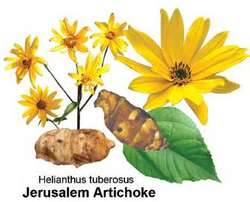helianthus tuberosus
Also found in: Dictionary, Thesaurus, Wikipedia.
Related to helianthus tuberosus: Helianthus angustifolius
jerusalem artichoke
Related to sunflowers. Not an artichoke. Yellow flowers, up to 9 ft tall. The root (tuber) is the part you want- it looks like ginger and is edible after first frost and throughout winter. Slice raw into salad. Root is made of inulin which is good for low-starch diets, treating diabetes and leaky gut syndrome. Inulin also feeds probiotics and multiplies the good flora in your gut, which helps fight candida yeast and aids digestion. The tubers are sometimes used as a substitute for potatoes. They have a similar consistency, and in their raw form have a similar texture, but a sweeter, nuttier flavor; raw and sliced thinly, they are fit for a salad. Can be steamed. Juice from the root is sweet and can be used as a sugar substitute by diabetics. Good for heartburn, high blood pressure and rheumatism. Inulin can’t be broken down by our digestive system, so it can cause gas. Hard thick sandpapery leaves and flowers used to make tea for rheumatism.
Edible Plant Guide © 2012 Markus Rothkranz
